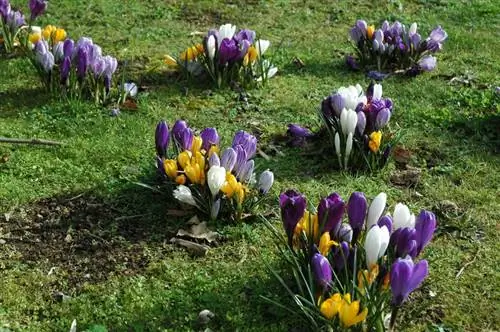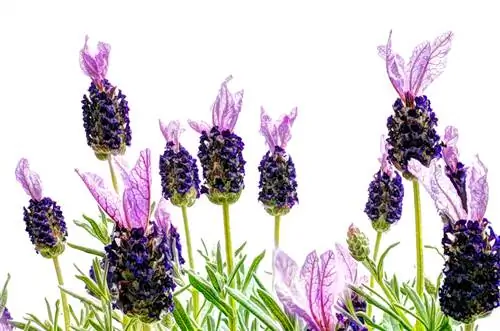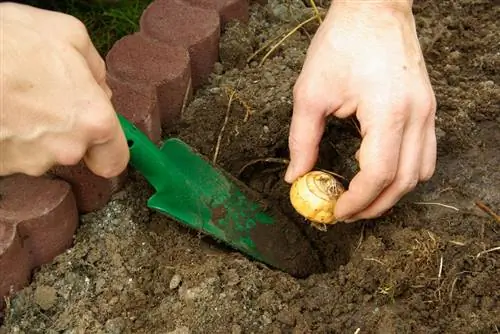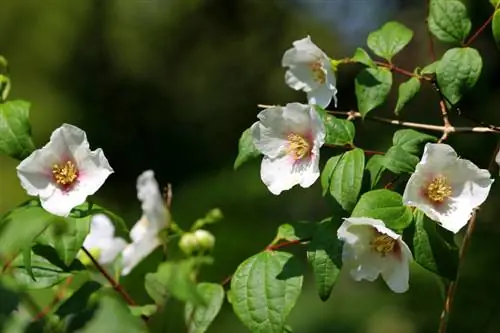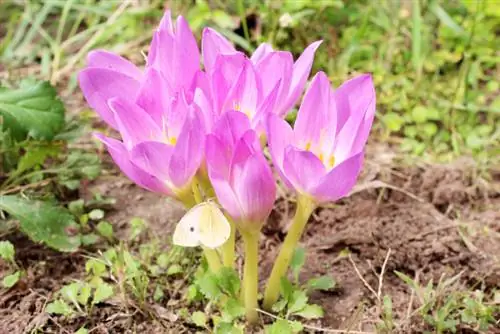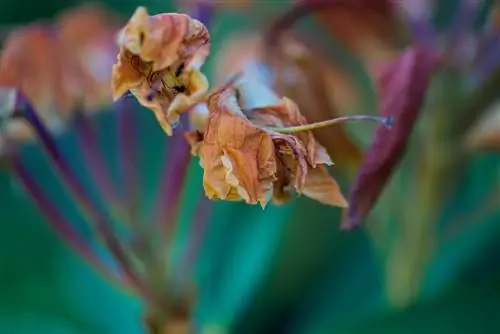- Author admin [email protected].
- Public 2023-12-25 17:45.
- Last modified 2025-01-23 11:22.
Crocuses drive away the melancholy of winter from the garden and herald the approach of spring. Reason enough to plant this colorful flower in large numbers in beds and lawns. All important questions about professional planting and care are answered here.

How to plant and care for crocuses in the garden?
Crocuses are planted in autumn (September and October) in sunny, warm locations at a depth of 7-10 cm. Care is simple: water regularly (especially in pots), fertilize every two weeks and remove the withered parts of the plant after flowering. They reproduce independently through daughter bulbs and seeds.
Planting crocus correctly
Since a crocus is a bulb-like bulbous flower, successful cultivation depends crucially on the quality of the planting material. Only plump, undamaged onion bulbs can be considered for planting in beds and lawns. In a sunny, warm location, follow these steps:
- Rake the soil thoroughly, weed and enrich it with sifted compost
- Dig planting holes 7-10 centimeters deep
- Insert flower bulbs in small groups with the tips pointing upwards
- Cover the planting site with soil, press down lightly and water a little
The elf-like flower also looks decorative in the pot or flower box. As a substrate, use a good quality compost-based potting soil enriched with a little sand for good permeability. Drainage at the bottom of the pot reliably prevents dangerous waterlogging. If you plant several crocuses next to each other, the flower bulbs should not touch each other.read more
Care tips
The care protocol for crocuses is easy to understand, even for beginner gardeners. If you cultivate the flower outdoors, Mother Nature takes over the water supply. Crocuses are only watered a little in planters when the substrate surface has dried. The flower enjoys a portion of compost with horn shavings or liquid fertilizer for potted plants every 2 weeks throughout the growing season.
The pivotal point of professional cultivation is pruning at the right time. After flowering, give crocuses enough time so that the tubers can absorb all the remaining nutrients from the leaves and flowers. Only then do you cut or mow off the completely withered parts of the plant.
What is the best time to plant?
So that crocuses bloom in their full glory in spring, the planting time is important. Choose a warm, dry day in September or October and you're in the right place. Autumn crocuses, on the other hand, come into the ground in August so that they can show what they're made of after 6-7 weeks.read more
When is flowering time?
The crocus genus contains both early flowering species and autumn bloomers. So the question about the flowering time is definitely justified. With the right combination, spring flowering can even be extended, as some species shine particularly early in the sun, while others do their best beyond Easter. The flowering period extends over these phases:
- Crocus chrysanthus, korolkowii, imperatii, elf crocuses and wild species bloom from the end of January/beginning of February to the end of March
- Crocus minimus, roseus and others bloom from early/mid-March to late April
- Crocus ligusticus, pulchellus and saffron crocus bloom from September to November
read more
Propagate crocuses
Properly planted in light, well-drained soil, crocuses reproduce completely independently using daughter bulbs and seeds. If you want to have an accelerated effect on the offspring, use the following procedure:
- Dig up the onion bulbs about 4 weeks after flowering
- Dispose of damaged, moldy or rotten specimens in household waste (not in the compost)
- Spread the crocus tubers on untreated newspaper in the airy, cool cellar
- At the beginning of the planting season, separate the onions with a sharp knife and plant them
Propagating crocuses by sowing is rarely practiced among hobby gardeners. Since these are cold germinators, the procedure is quite complex due to the stratification. In addition, you can only look forward to the first flowers after 4-5 years at the earliest.read more
Is crocus poisonous?
Spring-flowering crocuses can only be rated as slightly poisonous for small children. The flower poses no danger to adults. The danger potential of autumn-flowering crocuses is somewhat different. The saffron crocus is particularly worth mentioning here. Although this flower provides one of the most valuable spices in the world, excessive consumption causes serious poisoning.read more
Is the crocus poisonous to cats?
The popular spring flower is extremely toxic to cats due to its picrococin content. If your kitty likes to nibble on plants, crocuses are not suitable for beds and lawns. If the smallest amounts get into the stomach, they cause the worst symptoms of poisoning, which lead to a painful death.read more
A profile of the crocus
The following profile conveys all the attributes that are important for successful cultivation:
- Plant family: Iridaceae
- Genus: Crocuses (Crocus) with 80-100 species
- Hardy, herbaceous plant
- Onion-like tubers as a survival organ
- Growth height 5 to 15 centimeters
- Flowering time: depending on the species from February to March or October to November
- Capsule fruits with numerous seeds after flowering
- Lancelloid foliage, dark green and white edge or central stripe
- Special properties: poisonous
read more
The crocus bulbs
To protect crocus bulbs from damage, a vole basket works wonders. This is a close-meshed wire basket. You first place this in the planting hole to spread a thin layer of sand on the ground. Fill in the excavation enriched with compost and plant the crocus bulbs 7-10 centimeters deep. You can safely do without a lid because the pests do not penetrate to the surface of the earth.
The flower of the crocus
The seasonal duration of a crocus flower usually lasts 6-8 weeks. If the location meets the desired requirements, crocuses will quickly become wild and the pretty flowers will appear again every year in late winter or autumn.
To experience the impressive growth power contained in this 5 to 15 centimeter small flower, it is worth visiting the Husum crocus blossom. Every spring, more than 5 million crocuses bloom in rich purple on 50,000 square meters. The Crocus napolitanus species has been performing this floral miracle of the north for more than 300 years.read more
Crocus blooms in these colors
Crocuses bloom in all the colors of spring, with white, purple, violet and yellow dominating. Red and pink colors are rarely found. The individual flower is far from content with just one color. In fact, there are often different nuances on the outside than on the inside. 'Tricolor', for example, presents opulent colors with flowers in purple and white around a yellow center. The autumn crocus is in no way inferior to this with purple, dark-veined flowers and orange stigmas.
An unexpected effect comes with yellow crocuses. Since the petals are reminiscent of the yellow beaks of blackbirds, the birds in their vicinity turn into angry brawlers who challenge the apparent competitor to a duel. A solid yellow crocus bed quickly resembles a battlefield.read more
The seeds of the crocus
Once busy insects have fulfilled their duty, crocuses develop small capsule fruits after flowering. There are numerous seeds inside. Anyone who spares no effort as a hobby gardener harvests the fruits and grows the seeds. In order to motivate the seeds to germinate, they must be exposed to a cold stimulus. To do this, fill the seeds with moistened sand into a plastic bag that is kept tightly closed in the refrigerator.
After 4-6 weeks, the first cotyledons break through the seed coat. Now take the crocus seeds out of their cold quarters and carry out further sowing according to a tried and tested pattern. It takes up to 5 years for a young plant to present itself as a flower.read more
The early bloomer crocus
If you missed the ideal time for planting in autumn, you can still make up for it for early bloomers. Just a few days without frost are enough. Place the onion bulbs approx. 7 centimeters deep in the soil and add a little compost.
The crocus in autumn
So that crocuses can develop their full beauty in autumn, the tubers are planted in August. A sunny, sheltered location in the rock garden, gravel bed or in borders is ideal. Since autumn crocuses are not fond of food, they receive a portion of compost in the planting hole. In addition, the flower appreciates fertilizer every 4 weeks until the end of flowering.
In contrast to the spring crocus, the leaves remain on the plant through the winter after flowering. Only when all parts of the plant have completely withered can they be cut off next year.read more
Crocuses in the snow
If you are looking for the perfect plant neighbors for crocuses in the snow, you will find what you are looking for among popular early bloomers. You can create magical flower carpets with other bulbous plants, such as snowdrops, winter aconites and daffodils. Crocuses also create a harmonious appearance with snow shine, Marchenbrecher and anemones, none of which are afraid of a glittering blanket of snow.read more
The crocus species
It's not that easy to discover your new favorite flower among the almost 100 types of crocus. Suitable candidates for the title are:
- Crocus neapolitanus, the wild species from the Alps with purple flowers
- Crocus angustifolius, a yellow beauty, ideal for the lawn
- Crocus chrysanthus, the snow crocus to which we owe enchanting varieties
- Crocus etruscus, the Italian forest crocus, which also accepts wetter locations
- Crocus savitus, the autumnal crocus to which we owe the precious saffron spice
read more
The most beautiful varieties
- Prins Claus: pretty snow crocus with bright white cup flowers and purple spots on the outside
- Spring Beauty: small crocus fairy, whose purple flowers appear darkly feathery on the outside
- Tricolor: spring-like color spectacle in purple, white and yellow in every single flower
- Roseus: the spring flower with unique purple-pink flowers sets unmistakable accents
- Ruby Giant: lives up to the name with its large purple flowers
- De Jager: presents a festival of colors with cream-yellow, crimson-striped flowers
- Gipsy Girl: impresses with golden yellow cup flowers from February to the end of March
- Bowles Whites: award-winning crocus with bulbous goblet flowers in pure white and yellow throat
- Saffron: world-famous autumn crocus, whose fragrant pistil threads provide the sought-after spice
- Zephyr: magnificent crocus with white, blue-gray veined flowers from October to November

